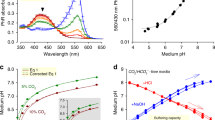Summary
Mouse NCTC clone 929 L (L-929) cells were propagated continuously over 2 yr in protein-free Eagles's minimal essential medium (EMEM). The cells designated L-929-WS were used for quality-control testing of protein-free EMEM as a model for more general medium quality tests. The parameter for the suggested quality control assay was the growth-promoting activity of the medium for L-929-WS cells. As an example of quality tests we assayed the growth promoting activity of EMEM exposed to various conditions of storage time and temperature. We established the sensitivity of the new assay by comparing it to the original cells L-929 grown in EMEM supplemented with 10% fetal bovine serum (FBS). The assay system using L-929-WS cells propagated continuously in protein-free medium proved to be much more sensitive. The sensitivity, however, was abolished by the addition of FBS in a concentration as low as 1% to a culture medium.
Similar content being viewed by others
References
Barnes, D.; Sato, G. Methods for growth of cultured cells in serum-free medium. Anal. Biochem. 102:255–270; 1980.
Barnes, D.; Sato, G. Serum-free cell culture: a unifying approach. Cell 22:649–655; 1980.
Buhl, S. N.; Regan, J. D. Growth of a human leukemia cell line on protein-free chemically defined medium. Proc. Soc. Exp. Biol. Med. 140:1224–1227; 1972.
Cinatl, J., Jr.; Cinatl, J.; Gerein, V., et al. The establishment and characterization of mouse L-929 cells in protein-free Eagle's minimal essential medium. J. Biol. Stand. 16:249–257; 1988.
Earle, W. R. Production of malignancy in vitro. IV. The mouse fibroblast cultures and changes seen in the living cells. JNCI 4:165–212; 1943.
Evans, V. J.; Bryant, J. C.; Fiaramonti, M. C., et al. Studies of nutrient media for tissue cells in vitro. I. A protein-free chemically defined medium for cultivation of stain L cells. Cancer Res. 16:77–86; 1956.
Evans, V. J.; Bryant, J. C.; McQuilkin, W. T., et al. Studies of nutrient media for tissue cells in vitro. II. An improved protein-free chemically defined medium for long-term cultivation of strain L-929 cells. Cancer Res. 16:87–94; 1956.
Iscove, N. N.; Melchers, F. Complete replacement of serum by albumin, transferrin and soybean lipids in cultures of lipopolysaccharide-reactive B lymphocytes. J. Exp. Med. 147:923–933; 1978.
Kaighn, M. E. Standards and testing procedures for media supplements and supplies. In: Patterson, M. K., ed. Uses and standardization of vertebrate cell cultures. In Vitro Monogr. No. 5 Gaithersburg, MD: Tissue Culture Association; 1984:83–90.
Mather, J.; Kaczarowski, F.; Gabler, R., et al. Effects of water purity and addition of common water contaminants on the growth of cells in serum-free media. Biotechniques 4:56–63; 1986.
McKeehan, W. L. Identifying the complete set of extracellular variables that influence cell multiplication in vitro. In: Patterson, M. K., ed. Uses and standardization of vertebrate cell cultures. In Vitro Monogr. No. 5. Gaithersburg, MD: Tissue Culture Association; 1984:83–90.
Okabe, T.; Fujisawa, M.; Takaku, F. Long-term cultivation and differentiation of human erythroleukemic cells in a protein-free chemically defined medium. Proc. Natl. Acad. Sci. USA 81:453–455; 1984.
Okabe, T.; Takaku, F. Long-term cultivation of a human colony-stimulating factor-producing cell line in a protein-free chemically defined medium. Cancer Res. 44:4503–4506; 1984.
Sanford, K. K.; Evans, V. J. A quest for the mechanism of “spontaneous” malignant transformation in culture with associated advances in culture technology. JNCI 68:895–913; 1982.
Sanford, K. K.; Earle, W. R.; Likely, G. D. The growth in vitro of single isolated tissue cells. JNCI 9:229–246; 1948.
Sato, G. H. The role of serum in cell culture. In: Litwick, G., ed. Biochemical action of hormones. New York: Academic Press; 1975:391–396.
Schaeffer, W. I. Usage of vertebrate, invertebrate and plant cell, tissue and organ culture terminology. In Vitro 20:19–24; 1984.
Skarnes, R. C. The inactivation of endotoxin after interaction with certain proteins of normal serum. Ann. NY Acad. Sci. 133:644–662; 1966.
Temin, H. M.; Pierson, R. W.; Dulak, N. C. The role of serum in the control. In: Rothblaat, G.; Christofalo, V. J., eds. Growth, nutrition and metabolism of cells in culture, vol. 1. New York: Academic Press; 1972:50–81.
Takoaka, T., Katsuta, H. Long-term cultivation of mammalian cell strains in a protein- and lipid-free chemically defined synthetic media. Exp. Cell Res. 67:295–304; 1971.
Ulewitch, R. J.; Johnston, A. R. The modification of biophysical and endotoxic properties of bacterial lipopolysaccharides by serum. J. Clin. Invest. 62:1313–1324; 1978.
Yamaguchi, N.; Okabe, T.; Kawai, K. J. Establishment of a human carcinoemryonic antigen (CEA)-producing cell line in a protein-free chemically defined medium. J. Cancer Res. Clin. Oncol. 110:42–47; 1985.
Yamaguchi, N.; Kawai, K. Acid protease secreted from human pancreatic carcinoma cell line HPC-YT into serum-free, chemically defined medium. Cancer Res. 46:5353–5359; 1986.
Author information
Authors and Affiliations
Rights and permissions
About this article
Cite this article
Cinatl, J., Cinatl, J., Rabenau, H. et al. A new assay system for quality control testing of a chemically defined medium. Journal of Tissue Culture Methods 12, 67–72 (1989). https://doi.org/10.1007/BF01404646
Issue Date:
DOI: https://doi.org/10.1007/BF01404646




